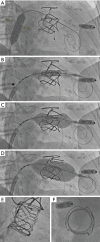Current state of transcatheter mitral valve implantation in bioprosthetic mitral valve and in mitral ring as a treatment approach for failed mitral prosthesis
- PMID: 34733687
- PMCID: PMC8505923
- DOI: 10.21037/acs-2021-tviv-80
Current state of transcatheter mitral valve implantation in bioprosthetic mitral valve and in mitral ring as a treatment approach for failed mitral prosthesis
Abstract
With heightened awareness of mitral valve disease and improvement in surgical techniques, the use of mitral valve bioprostheses has increased. There is a large aging population with prior surgical valvular interventions. Limited durability of the prosthesis due to valvular degeneration over time may necessitate the need for repair or replacement of the prior prosthesis in the future. This usually entails another surgical intervention in this population with elevated risk for a reoperation. There is an ongoing clinical need for newer, less invasive options that are feasible and carry a lower complication rate. The advent of transcatheter heart valve (THV) therapies has opened up a wide range of therapeutic options for treatment of a failed bioprosthesis. Their safety and feasibility are now well established. This article serves as a review of the currently available THVs for implantation in the mitral position, the pre-procedural assessment, the challenges associated with implantation, as well as outcomes associated with a mitral valve-in-valve (VIV) and a mitral valve-in-ring (VIR) procedure.
Keywords: Valve-in-valve (VIV); mitral valve bioprosthesis; surgical heart valve; transcatheter heart valve (THV); transcatheter mitral valve replacement (TMVR); valve-in-ring (VIR).
2021 Annals of Cardiothoracic Surgery. All rights reserved.
Conflict of interest statement
Conflicts of Interest: The authors have no conflicts of interest to declare.
Figures









References
Publication types
Grants and funding
LinkOut - more resources
Full Text Sources
